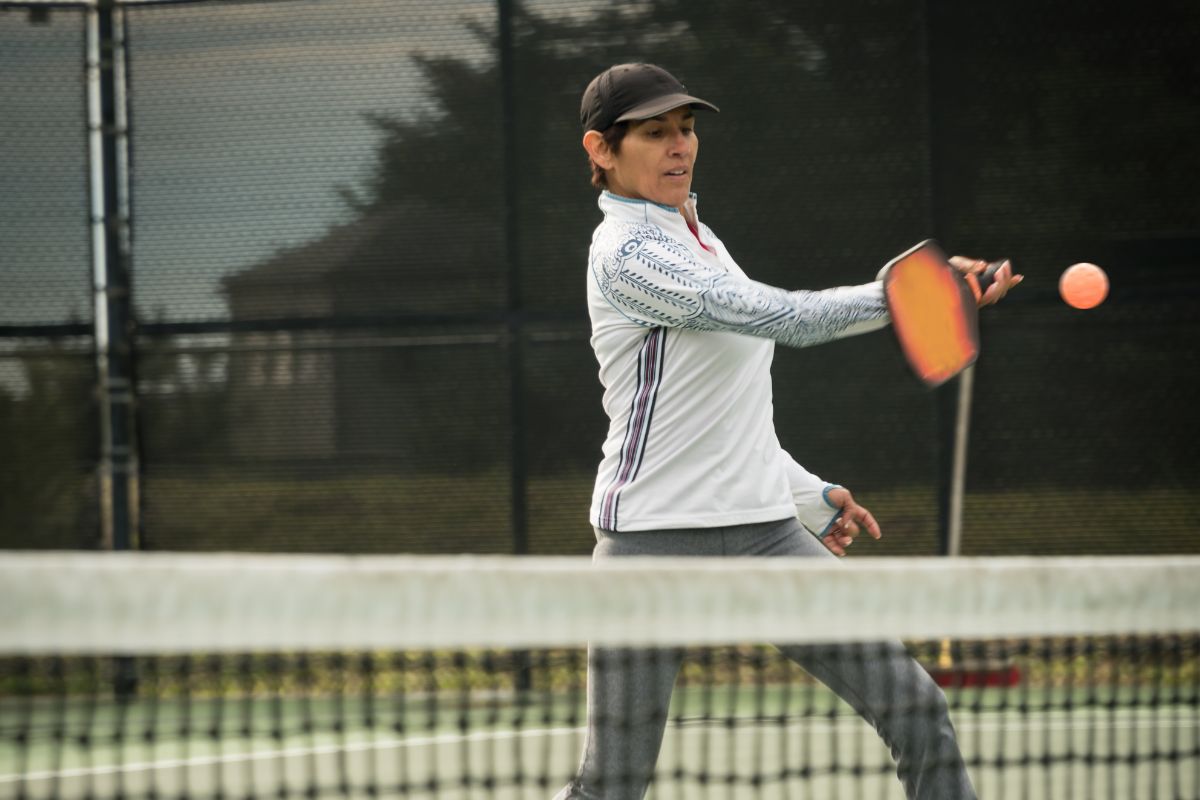As a player improves in pickleball and comes up against more experienced players, they will encounter a few incredibly unique shots and techniques with some peculiar names that can seem incredibly confusing upon first hearing them.

The “Bert Shot” is one of these strange but useful techniques that can help give a team the advantage when a game might not be going their way, or when they need to pull out a shot that they know will throw off the opponent.
To get you up to speed on this advanced technique, here is everything you need to know about the Bert shot, including why it is considered so risky, and when it can be used during a game.
What Is A Bert Shot?
A Bert shot refers to when a player jumps over to the kitchen on the opposite side of the court to volley the ball.
This is very similar to the Ernie, which is where a player executes a volley outside the non-volley zone in the out-of-bounds area, making the shot a surprise for the opponent who struggles to anticipate and return it.
A player will therefore often jump from one side of the court to the other while stretching their arm out so that they can return the ball on the volley while their paddle and hand are reaching over their own kitchen area.
The name actually comes from Erne Perry who was seen using the shot in a few of his matches during the 2010 USAPA National Pickleball Tournament in Arizona.
Erne was not the one who first came up with the shot, but he was one of the first professional players to be recorded using it with videographer Jeff Shank catching Erne pulling this technique off multiple times on video.
What Is The Difference Between A Bert And An Erne?
While the two Sesame Street muppets, Bert and Erne, look quite different in their appearance but share the same sense of humor, the Bert and Erne shots in pickleball are much the same, serving the same purpose and working the same way, but differ in how they are actually executed.
With an Erne, which is the more popular shot of the two, a player will actually position themselves so that they are outside of the court and just next to the kitchen area on their side.
The aim of the Erne is to lean or jump in from this side of the court and volley the ball from the kitchen area, delivering a quick and responsive return that is nearly impossible for the opponent to strike back.
When a player is executing a Bert, they tend to still be on either the left or right side of the playing area, with the goal being to volley the ball by jumping over onto the opposite side of their own court and where their partner is usually standing.
Is A Bert Legal In Pickleball?
The official pickleball rules state that a player is restricted from volleying a ball from the non-volley zone, while they are standing on that area of the court themselves.
The Bert therefore negates this rule since the player is leaping over the kitchen, rather than standing in it and anticipating the return.
Because of this loophole, the Bert, just like the Erne, is completely legal and can sometimes be seen being used by top players in professional tournaments, usually when they want to put an end to an ongoing fierce rally.
How Difficult Is It To Hit A Bert?

Many pickleball players agree that a Bert is incredibly hard to pull off correctly and effectively because of how spontaneous the technique is, and how fast your reflexes need to be to know when the best time to use it is.
For example, while hitting an Erne is still an advanced level technique usually only utilized by professional players or those with tremendous experience, because the player is given a bit of time to run to the out-of-bounds area of the court, it does mean they can prepare and anticipate the next shot.
You get much less time to prepare when hitting a Bert, and will need to identify when the time is right to leap in front of your opponent and make the return since so many things can go wrong if it isn’t executed correctly.
Because of this, the Bert is incredibly rare and is rarely seen anymore in professional tournaments because of how much risk is associated with even attempting one.
Why The Bert Is Such A Risky Shot?
There are two main reasons why the Bert is seen as too risky to pull off in most scenarios, one is the fact that a player will be completely obstructing the view of their partner by hitting one since they will need to leap in front of them to try and make the return.
If the player attempting the Bert misses this return, it can cause tension within the team since they may have just cost the team a point, especially if a rally was ongoing. The second risk is simply executing a volley in the non-volley zone.
Leaping and hitting an effective volley takes an extraordinary amount of agility and athleticism, which is why it can be very easy for a player to place their foot on the ground to gain some balance or if they leap from too far away.
This means many players can accidentally volley the ball while standing in the non-volley zone, which would be considered a fault.
Both of these risks mean that the Bert is incredibly situational and is only used in scenarios where the player is certain that they are going to make contact with the ball and get enough airtime without ruining the opportunity for their partner to return.
Benefits Of A Bert Shot
While it does come with a few risks, there are several benefits from executing a successful Bert, such as the fact that it is near-impossible to return since you are returning the ball so close to the net, giving the opponent no time to react.
This also means the Bert is a good technique to throw your opponent off their game since many players, even those who are a lot more experienced, never expect a Bert to be successfully attempted during a game, so when it is, it can cause the opponent to wonder what else you might have up your sleeve.
A Bert is also a snappy and effective way to put an end to a rally and is especially useful if the other team is stretching you and your partner across the court with their shots.
If you feel that the opposing team is getting the best of you during a rally and that they are close to securing a point, a quick Bert shot can quickly put an end to their dominance and give you an edge in the game if you can manage to pull it off.
Summary
While it is incredibly hard to execute and is usually reserved for players who have an enormous amount of practice and experience in the sport, anyone can try out the Bert if they really feel they have the agility to pull it off during a match.
- What Kind Of Ball Is Used In Pickleball? - July 13, 2023
- How Much Does It Cost To Build A Pickleball Court? - July 11, 2023
- When Do New Pickleball Rules Take Effect? - July 8, 2023










